Investigation on Solidification in Cu-20wt%Fe Alloy through In Situ Observation
Abstract
1. Introduction
2. Materials and Methods
2.1. Experimental Materials
2.2. DSC Measurements
2.3. In Situ Observation
2.4. Microstructure Studies
3. Result and Discussion
3.1. Expected Solidification Process
3.2. CLSM Observation
3.3. Solidification Microstructure
4. Conclusions
- During the solidification process of the Cu-20Fe alloy, the remelting of primary γ-Fe dendrites was directly observed by CLSM. Moreover, the γ-Fe dendrites were fragmented due to remelting, and thus, the grain structure of the Fe phase may be improved by external forces within the remelting stage.
- The morphology of γ-Fe dendrites was significantly affected by the cooling rate. The dendritic morphology of γ-Fe on the interface changed from a cellular-like structure to a typical finer and longer dendritic structure as the cooling rate increased from 0.3 °C/s to 5.0 °C/s. The growth rate of the γ-Fe dendrite tip has a parabolic relationship with time, ν = 45.8 × t−0.34, where the temperatures were between 1286.5 and 1282.8 °C at the cooling rate of 0.3 °C/s. The growth rate also exhibits a parabolic relationship with time at cooling rates of 1.5 °C/s, where ν = 69 × t−0.13, and 5.0 °C/s, where ν = 40.1 × t−0.28. The dendrite tip growth rate at the solid–liquid interface increased with the cooling rate.
- The volume fractions of the Fe phase in samples cooled at 0.3, 1.5, and 5.0 °C/s were 16.58, 11.13, and 5.32%, respectively, showing a gradual decrease with an increase in the cooling rate. The prediction formula of SDAS for the Cu-20wt%Fe alloy within the studied cooling rate range was established as .
- The degree of constitutional undercooling was calculated in combination with the analysis of the sample data. The dendrite morphology becomes more complex as the constitutional undercooling increases. Simultaneously, the growth of the primary γ-Fe phase was inhibited by insufficient diffusion of Fe and Cu at the solidification front, resulting in a decrease in the volume fraction of the Fe phase in the samples.
Author Contributions
Funding
Data Availability Statement
Conflicts of Interest
References
- Wang, M.; Jiang, Y.; Li, Z.; Xiao, Z.; Lei, Q. Microstructure evolution and deformation behaviour of Cu-10wt%Fe alloy during cold rolling. Mater. Sci. Eng. A 2021, 801, 140379. [Google Scholar] [CrossRef]
- Yuan, D.; Xiao, X.; Luo, X.; Wang, H.; Han, B.; Liu, B.; Yang, B. Effect of multi-stage thermomechanical treatment on Fe phase evolution and properties of Cu-6.5 Fe-0.3 Mg alloy. Mater. Charact. 2022, 185, 111707. [Google Scholar] [CrossRef]
- Liu, S.; Jie, J.; Guo, Z.; Yue, S.; Li, T. A comprehensive investigation on microstructure and magnetic properties of immiscible cu-Fe alloys with variation of Fe content. Mater. Chem. Phys. 2019, 238, 121909. [Google Scholar] [CrossRef]
- Zhang, P.; Lei, Q.; Yuan, X.; Sheng, X.; Li, Y.; Li, Z. Microstructure and mechanical properties of a cu-Fe-Nb alloy with a high product of the strength times the elongation. Mater. Today Commun. 2020, 25, 101353. [Google Scholar] [CrossRef]
- Jo, H.R.; Kim, J.T.; Hong, S.H.; Kim, Y.S.; Park, H.J.; Park, W.J.; Park, J.M.; Kim, K.B. Effect of silicon on microstructure and mechanical properties of Cu-Fe alloys. J. Alloys Compd. 2017, 707, 184–188. [Google Scholar] [CrossRef]
- Hong, S.I. Copper-iron filamentary microcomposites. Adv. Eng. Mater. 2001, 3, 475–479. [Google Scholar] [CrossRef]
- Biselli, C.L.; Morris, D.G. Microstructure and strength of Cu-Fe in situ composite obtained from prealloyed Cu-Fe powders. Acta Met. Mater. 1994, 42, 163–176. [Google Scholar] [CrossRef]
- Verhoeven, J.D.; Chueh, S.C.; Gibson, E.D. Strength and conductivity of in situ Cu-Fe alloys. J. Mater. Sci. 1989, 24, 1748–1752. [Google Scholar] [CrossRef]
- Hodge, W.; Happe, R.A.; Gonser, B.W. High strength copper-silver, copper-iron, and copper-iron-chromium wire. Wire Wire Prod 1951, 26, 1033–1038. [Google Scholar]
- Spitzig, W.A.; Trybus, C.L.; Verhoeven, J.D. Metal Matrix Composites: Processing and Interfaces; Everett, R.K., Arsenault, R.J., Eds.; Academic Press: New York, NY, USA, 2009. [Google Scholar]
- Gao, H.; Wang, J.; Shu, D.; Sun, B. Effect of Ag on the microstructure and properties of Cu-Fe in situ composites. Scr. Mater. 2005, 53, 1105–1109. [Google Scholar] [CrossRef]
- Fernee, H.; Nairn, J.; Atrens, A. Precipitation hardening of Cu-Fe-Cr alloys part I Mechanical and electrical properties. J. Mater. Sci. 2001, 36, 2711–2719. [Google Scholar] [CrossRef]
- Sun, B.; Gao, H.; Wang, J.; Da, S. Strength of deformation processed Cu-Fe-Ag in situ composites. Mater. Lett. 2007, 61, 1002–1006. [Google Scholar] [CrossRef]
- Li, Y.; Yi, D.Q.; Zhang, J.B. Comparative study of the influence of Ag on the microstructure and mechanical properties of Cu-10Fe in situ composites. J. Alloys Compd. 2015, 647, 413–418. [Google Scholar] [CrossRef]
- Song, J.S.; Hong, S.I. Strength and electrical conductivity of Cu-9Fe-1.2Co filamentary microcomposite wires. J. Alloys Compd. 2000, 311, 265–269. [Google Scholar] [CrossRef]
- Zhang, J.T.; Cui, X.C.; Wang, Y.H. Liquid phase separation in immiscible Cu-Fe alloys. Int. J. Cast Met. Res. 2017, 31, 87–92. [Google Scholar] [CrossRef]
- Sun, X.; Hao, W.; Geng, G.; Ma, T.; Li, Y. Solidification microstructure evolution of undercooled Cu-15wt.%Fe alloy melt. Adv. Mater. Sci. Eng. 2018, 6, 6304518. [Google Scholar]
- Wu, Y.; Wang, W.; Chang, J.; Wei, B. Evolution kinetics of microgravity facilitated spherical macrosegregation within immiscible alloys. J. Alloys Compd. 2018, 763, 808–814. [Google Scholar] [CrossRef]
- Luo, S.B.; Wang, W.L.; Chang, J.; Xia, Z.C.; Wei, B. A comparative study of dendritic growth within undercooled liquid pure Fe and Fe50Cu50 alloy. Acta Mater. 2014, 69, 355–364. [Google Scholar] [CrossRef]
- Sohn, I.; Dippenaar, R. In-situ observation of crystallization and growth in high-temperature melts using the confocal laser microscope. Metal. Mater. Trans. B 2016, 47, 2083–2094. [Google Scholar] [CrossRef]
- Cheng, B.I.; Guo, Z.P.; Litottl, E.; Grant, P.S. Quantification study on dendrite fragmentation in solidification process of alluminum alloys. Acta Met. Sin. 2015, 51, 677–684. [Google Scholar]
- Wang, S.; Kang, J.; Guo, Z.; Lee, T.L.; Zhang, X.; Wang, Q.; Deng, C.; Mi, J. In situ high speed imaging study and modelling of the fatigue fragmentation of dendritic structures in ultrasonic fields. Acta Mater. 2018, 165, 388–397. [Google Scholar] [CrossRef]
- Kurz, W.; Fisher, D.J. Fundamentals of Solidification; Trans Tech Publications: Zurich, Switzerland, 1998. [Google Scholar]
- Edvardsson, T.; Fredriksson, H.; Svensson, I. A study of the solidification process in low-carbon manganese steels. Met. Sci. J. 2013, 10, 298–306. [Google Scholar] [CrossRef]
- Wilson, H.W. On the velocity of solidification and viscosity of super-cooled liquids. J. Phy. Chem. 1900, 50, 238–250. [Google Scholar] [CrossRef]
- Frenkel, J. Note on a relation between the speed of crystallization and viscosity. Phisik. Zeit. Sowjetunion 1932, 1, 498–510. [Google Scholar]
- Brito, C.; Nguyen-Thi, H.; Mangelinck-Noël, N.; Cheung, N.; Spinelli, J.E.; Garcia, A. Cellular-to-dendritic and dendritic-to-cellular morphological transitions in a ternary Al-Mg-Si alloy. IOP Conf. Ser. Mater. Sci. Eng. 2019, 529, 012018. [Google Scholar] [CrossRef]
- Kurz, W.; Fisher, D.J. Dendrite growth at the limit of stability: Tip radius and spacing. Acta Met. 1981, 29, 11–20. [Google Scholar] [CrossRef]
- Glicksman, M.E. Principles of Solidification: An Introduction to Modern Casting and Crystal Growth Concepts; Springer: Berlin/Heidelberg, Germany; Wiley: Hoboken, NJ, USA, 2010. [Google Scholar]
- Tiller, W.A.; Jackson, K.A.; Rutter, J.W.; Chalmers, B. The redistribution of solute atoms during the solidification of metals. Acta Met. 1953, 1, 428–437. [Google Scholar] [CrossRef]
- Burton, J.A.; Prim, R.C.; Slichter, W.P. The distribution of solute in crystals grown from the melt. Part I. theoretical. J. Chem. Phys. 1953, 21, 1987–1991. [Google Scholar] [CrossRef]
- Phelan, D.; Reid, M.; Dippenaar, R. Kinetics of the peritectic reaction in an Fe-C alloy. Mater. Sci. Eng. A 2008, 477, 226–232. [Google Scholar] [CrossRef]
- Cao, J.; Hou, Z.; Guo, D.; Guo, Z.; Tang, P. Morphology characteristics of solidification structure in high-carbon steel billet based on fractal theory. J. Mater. Sci. 2019, 54, 12851–12862. [Google Scholar] [CrossRef]
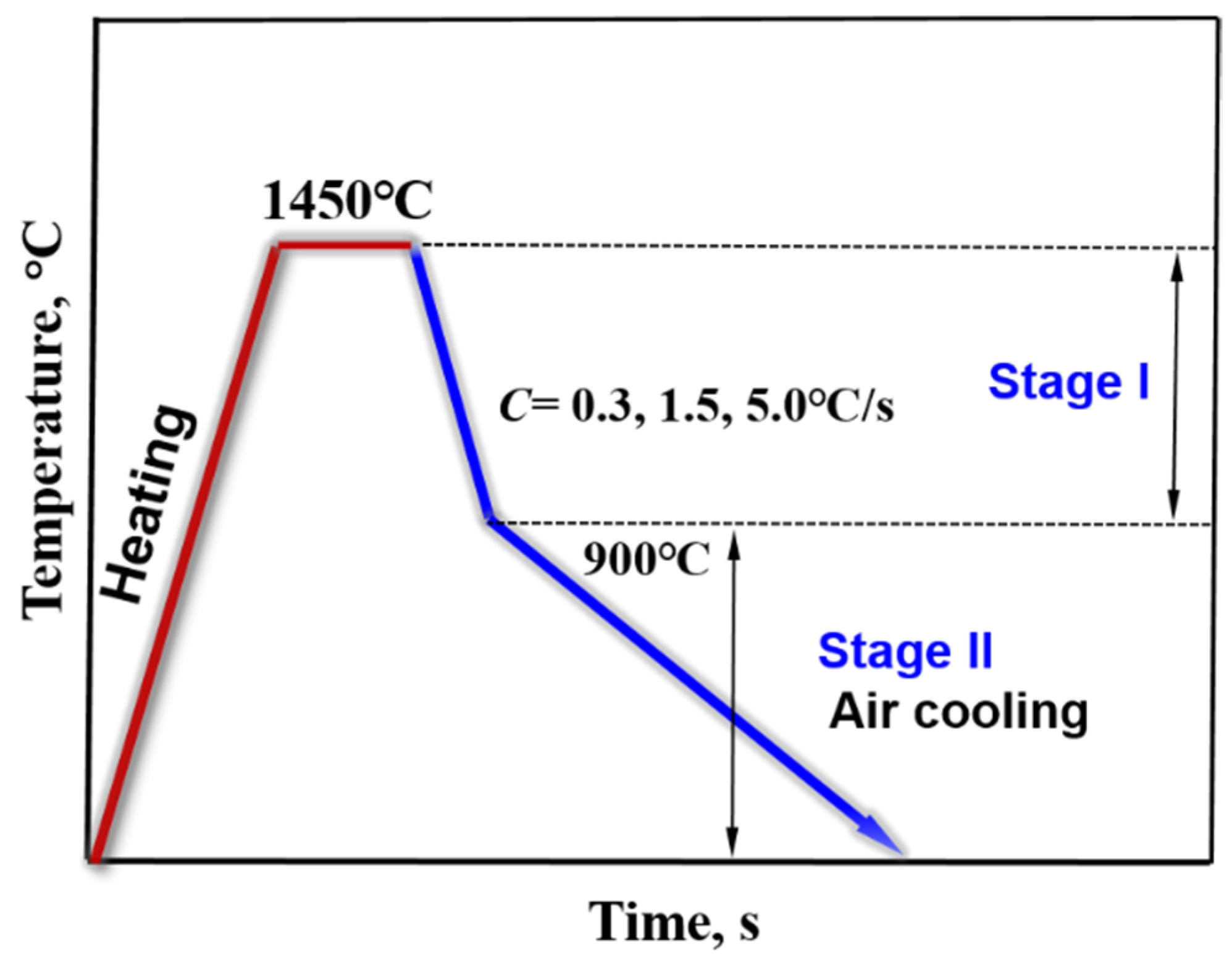
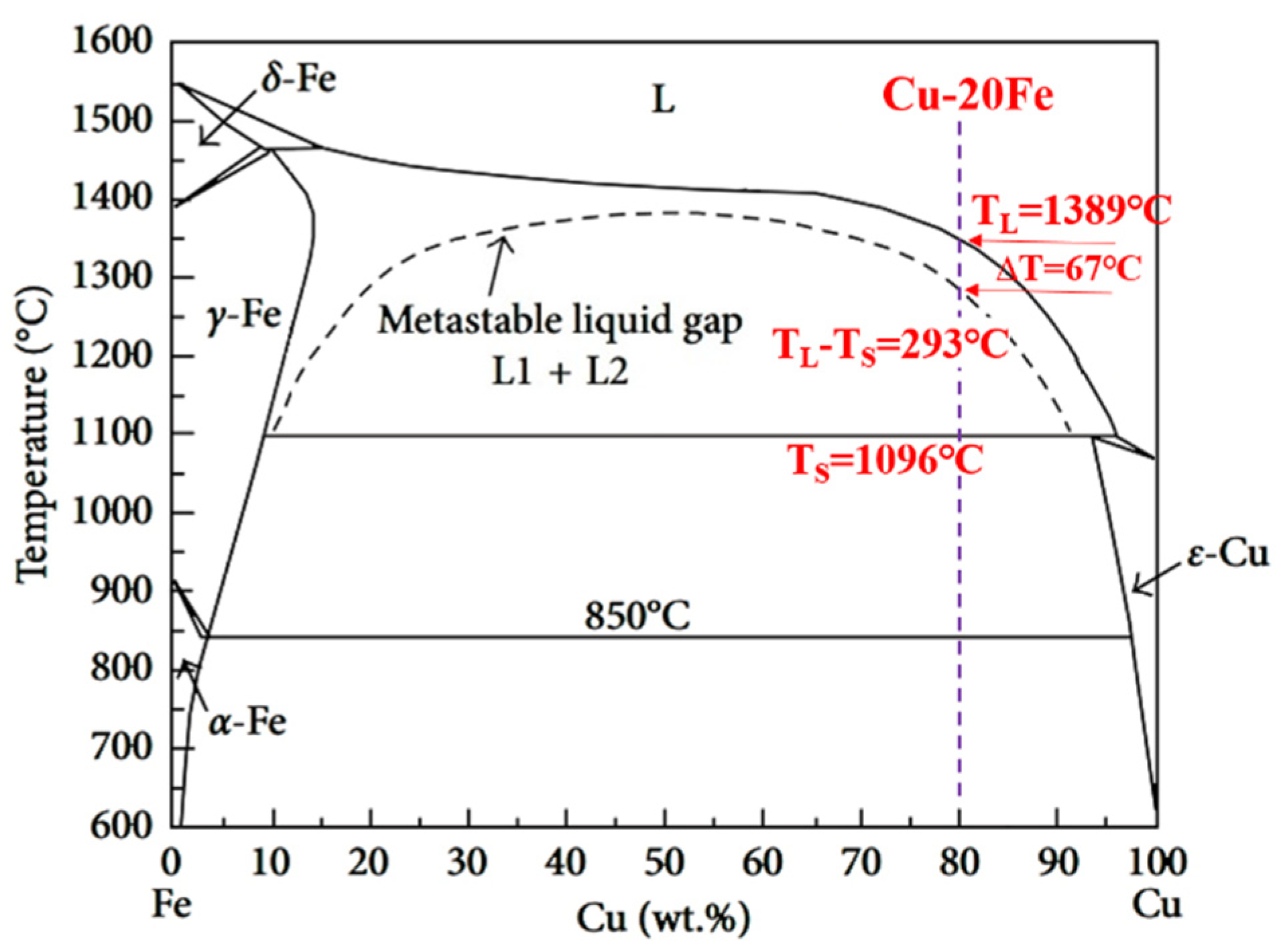
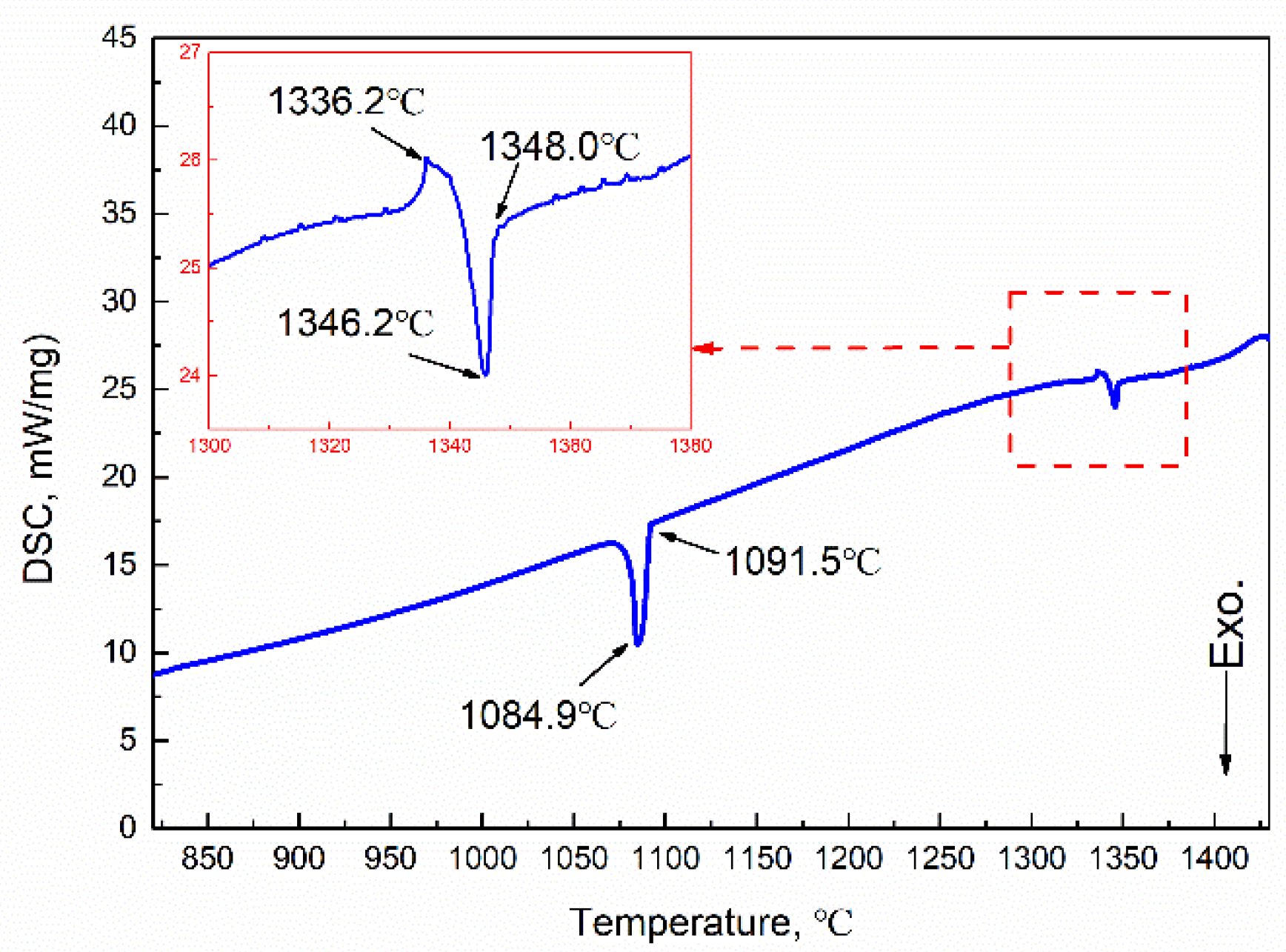
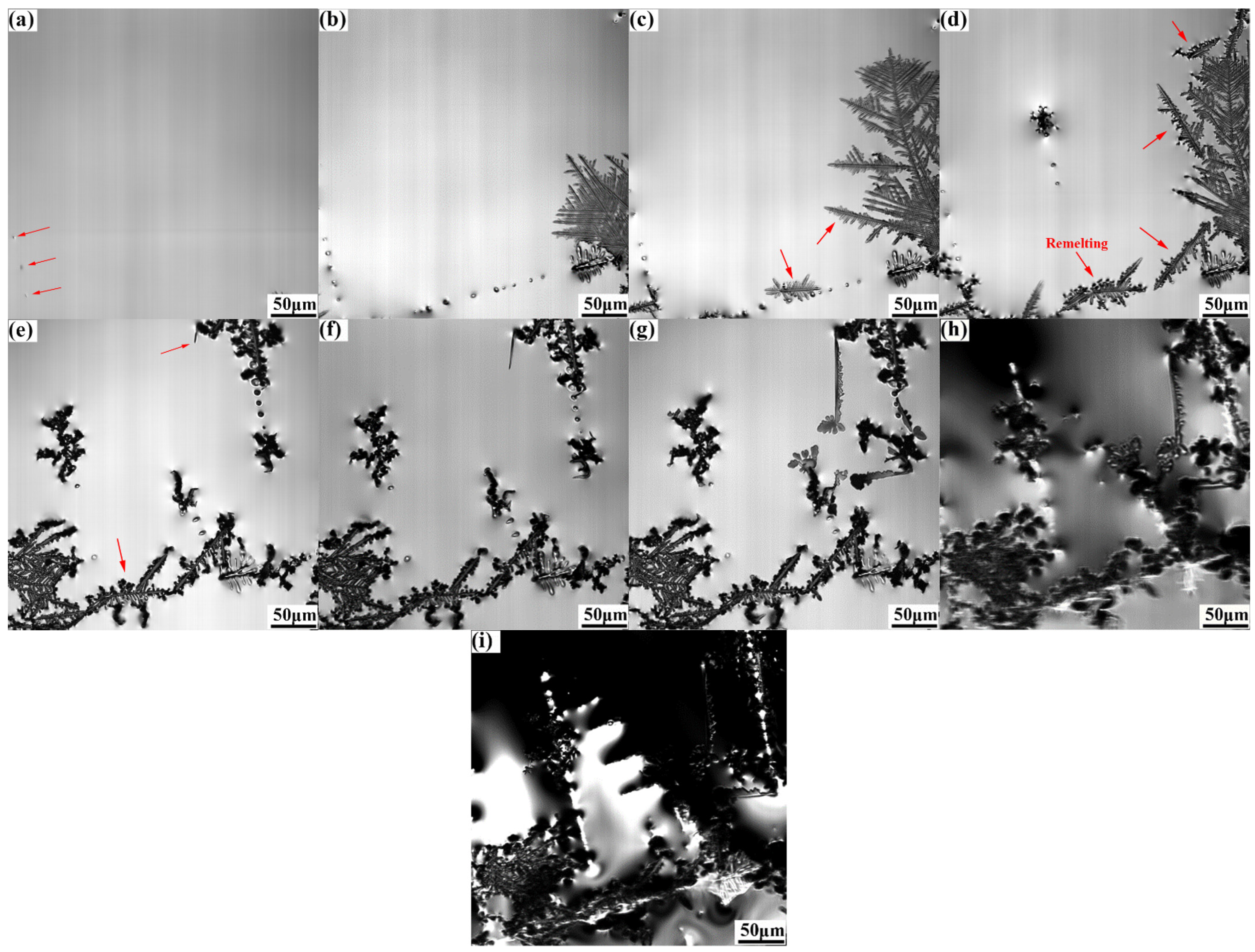

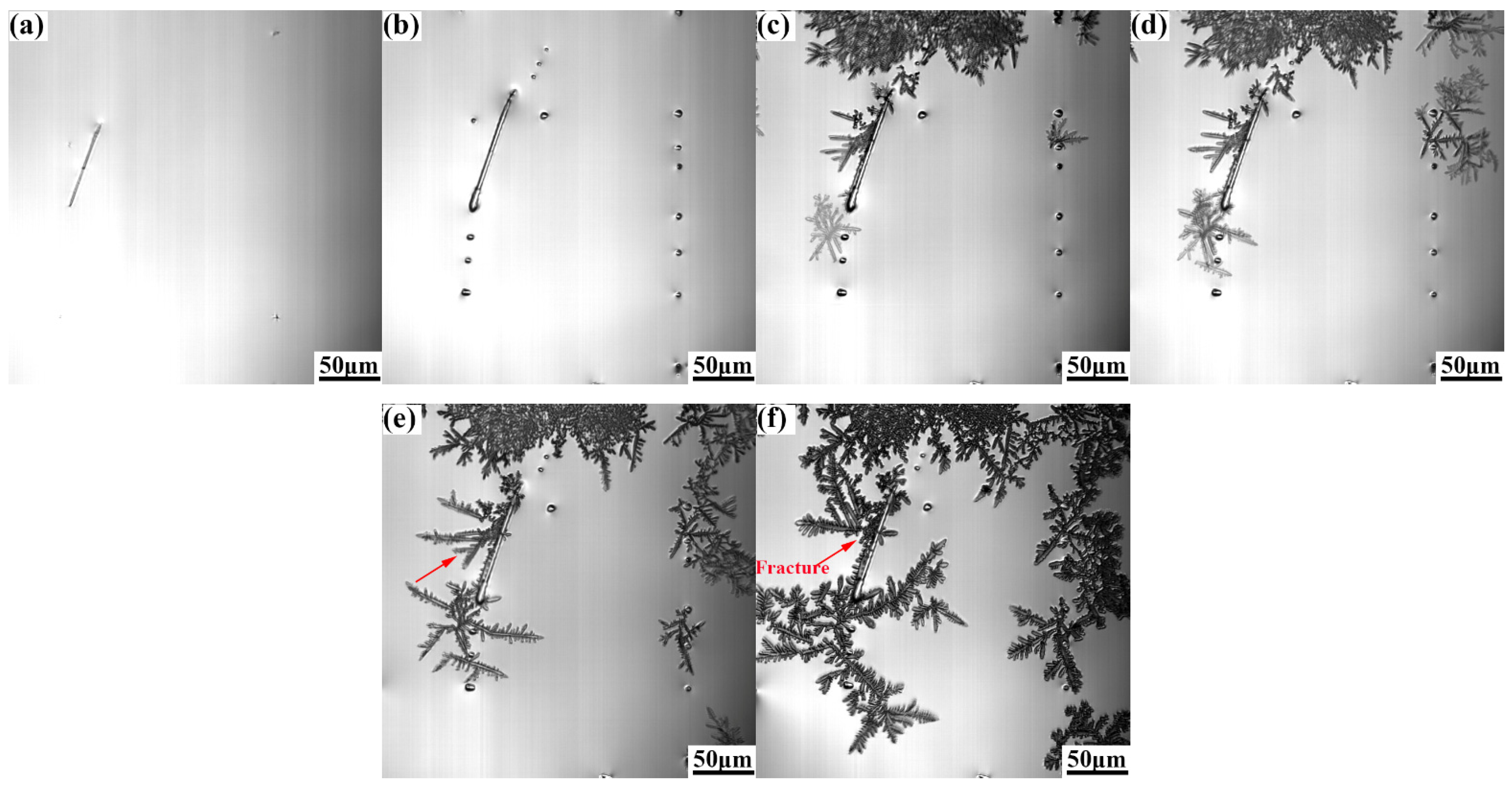
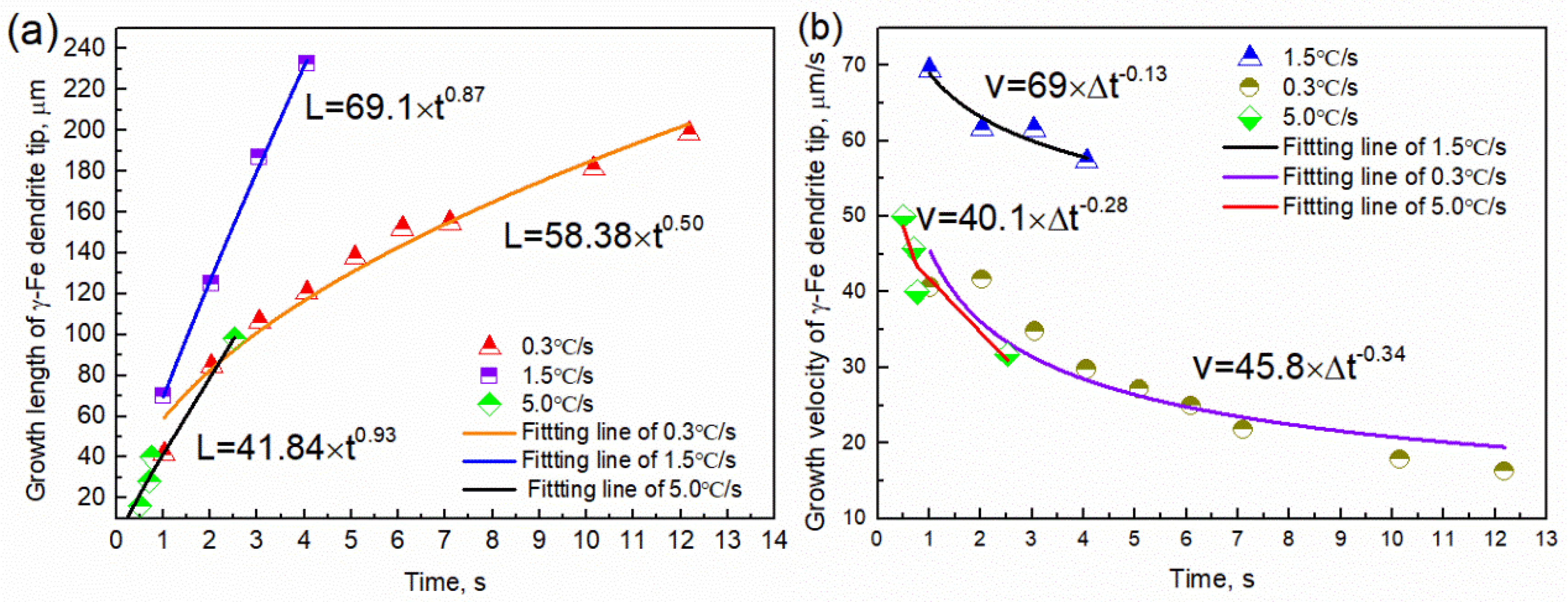

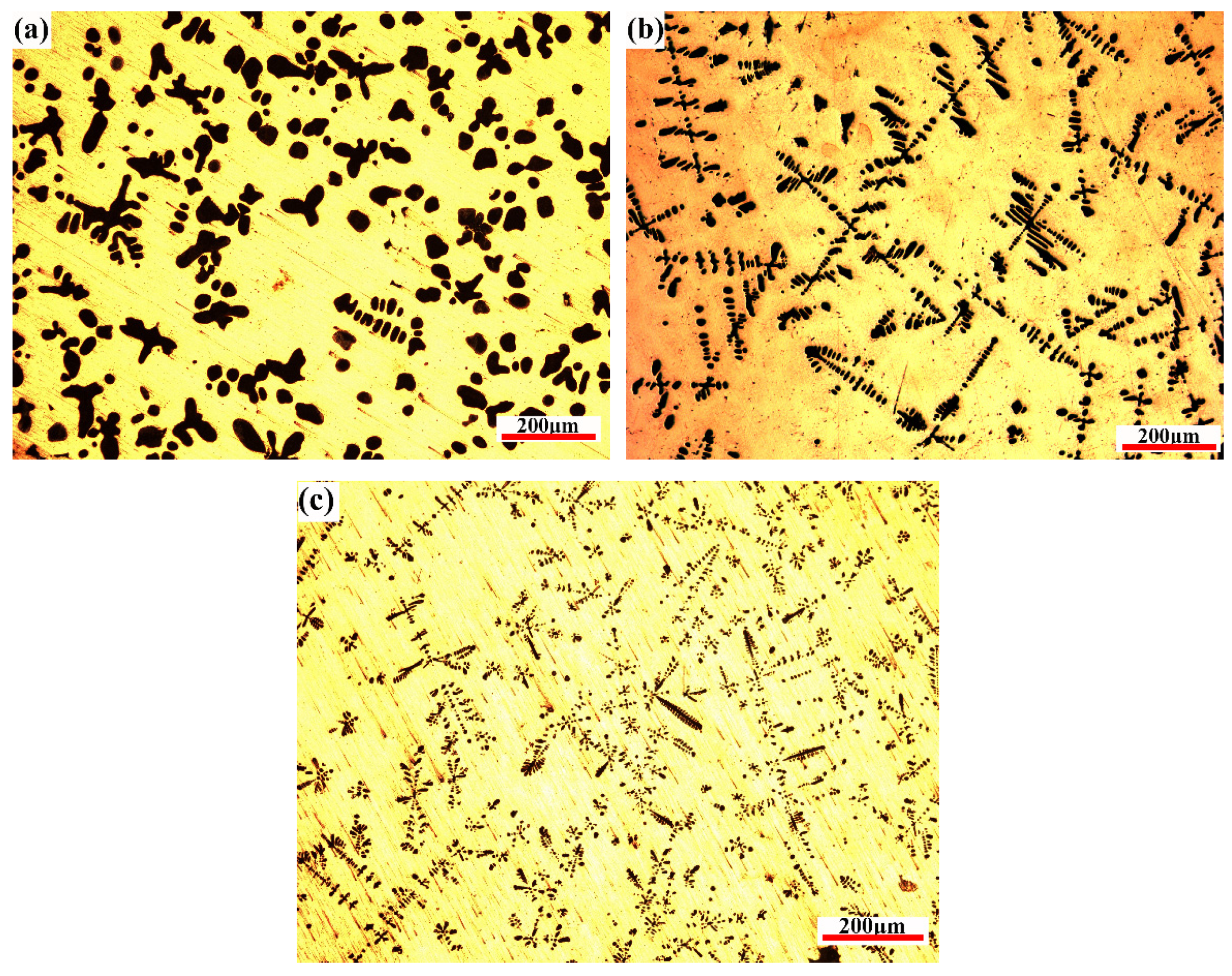

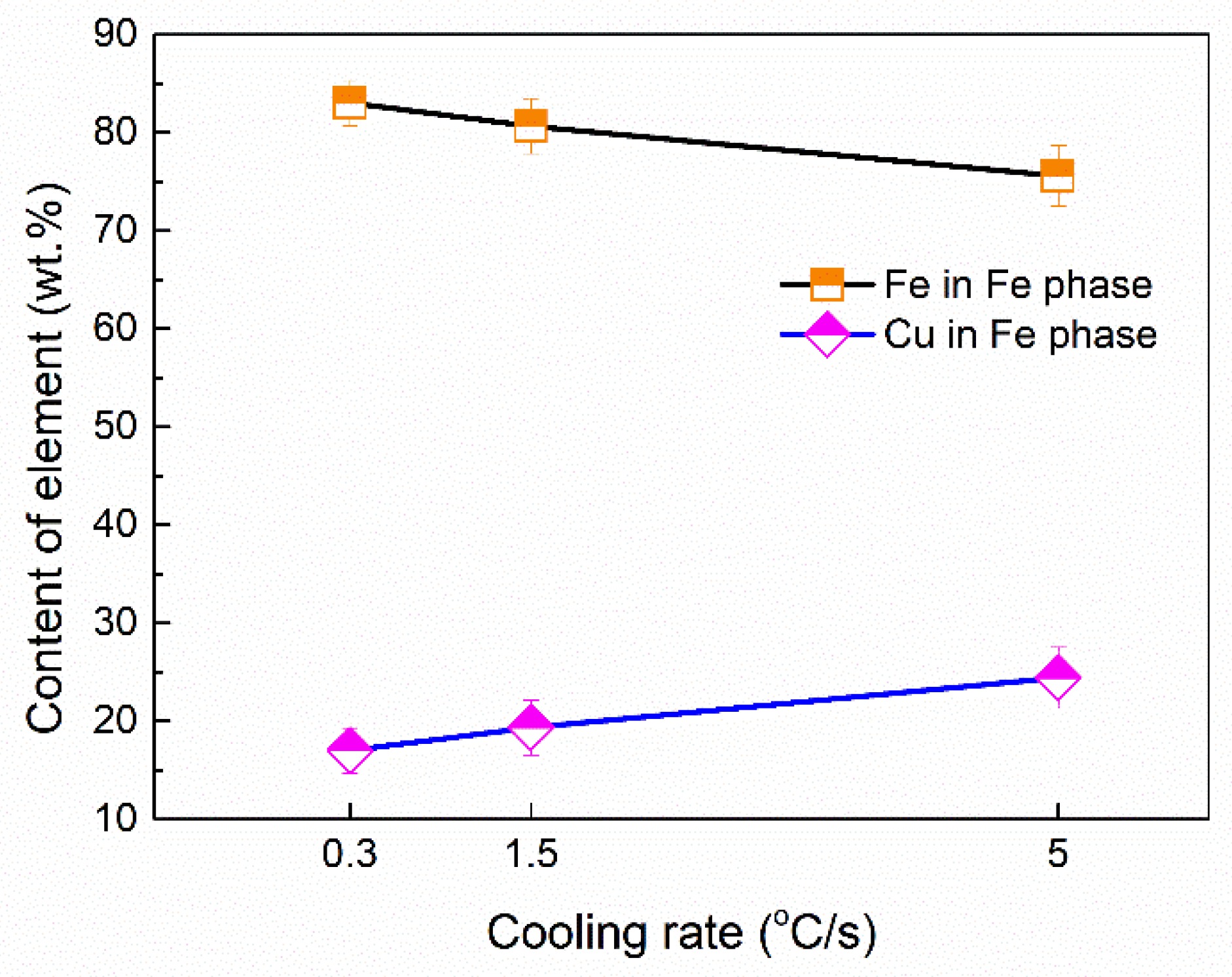

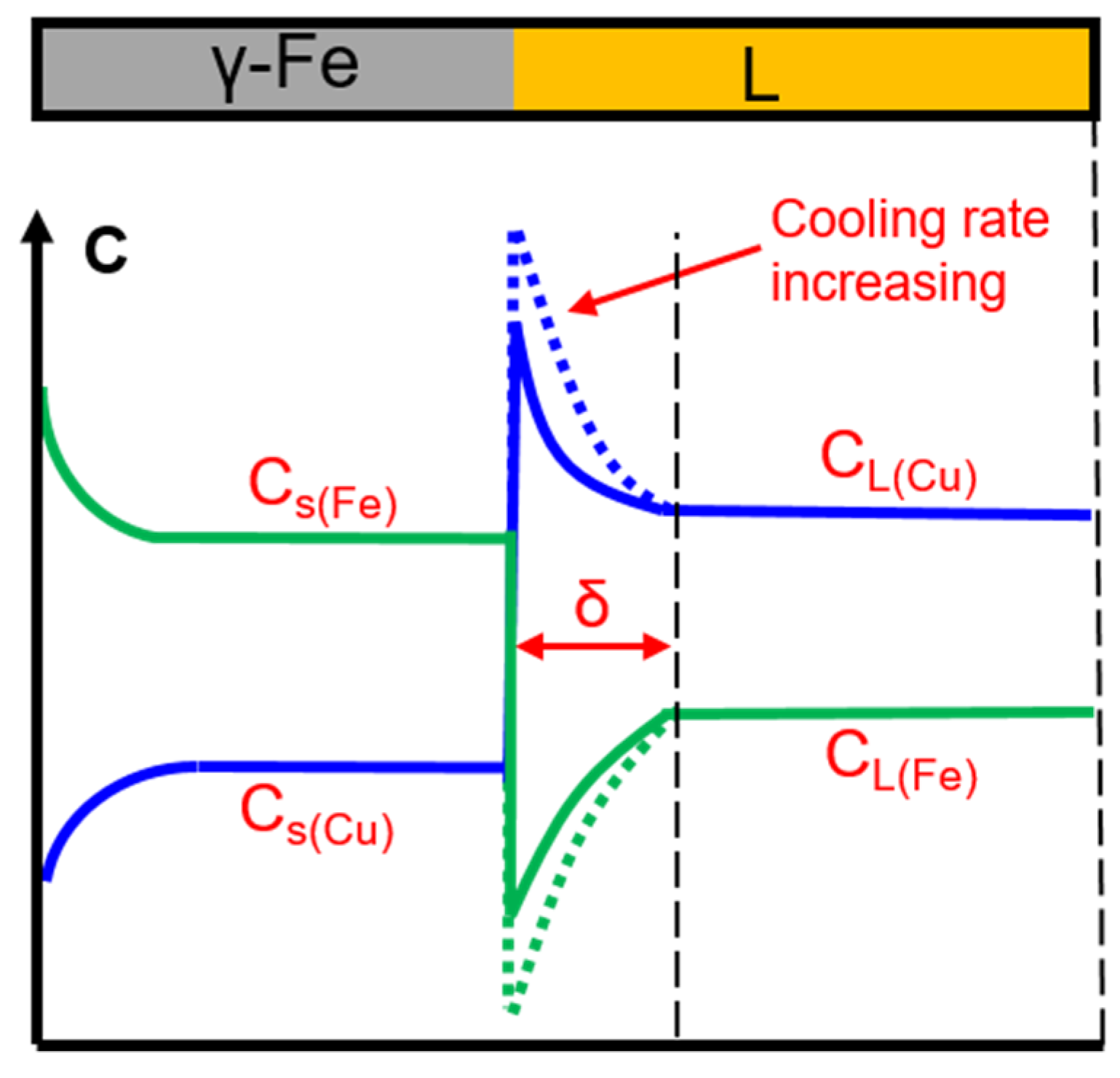
| Cooling rate | 0.3 °C/s | 1.5 °C/s | 5.0 °C/s |
| Mean SDAS, μm | 22.73 ± 4.5 | 14.30 ± 2.3 | 8.27 ± 2.1 |
Disclaimer/Publisher’s Note: The statements, opinions and data contained in all publications are solely those of the individual author(s) and contributor(s) and not of MDPI and/or the editor(s). MDPI and/or the editor(s) disclaim responsibility for any injury to people or property resulting from any ideas, methods, instructions or products referred to in the content. |
© 2023 by the authors. Licensee MDPI, Basel, Switzerland. This article is an open access article distributed under the terms and conditions of the Creative Commons Attribution (CC BY) license (https://creativecommons.org/licenses/by/4.0/).
Share and Cite
Guo, J.; Lu, D.; Zou, J. Investigation on Solidification in Cu-20wt%Fe Alloy through In Situ Observation. Metals 2023, 13, 581. https://doi.org/10.3390/met13030581
Guo J, Lu D, Zou J. Investigation on Solidification in Cu-20wt%Fe Alloy through In Situ Observation. Metals. 2023; 13(3):581. https://doi.org/10.3390/met13030581
Chicago/Turabian StyleGuo, Junli, Deping Lu, and Jin Zou. 2023. "Investigation on Solidification in Cu-20wt%Fe Alloy through In Situ Observation" Metals 13, no. 3: 581. https://doi.org/10.3390/met13030581
APA StyleGuo, J., Lu, D., & Zou, J. (2023). Investigation on Solidification in Cu-20wt%Fe Alloy through In Situ Observation. Metals, 13(3), 581. https://doi.org/10.3390/met13030581





